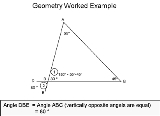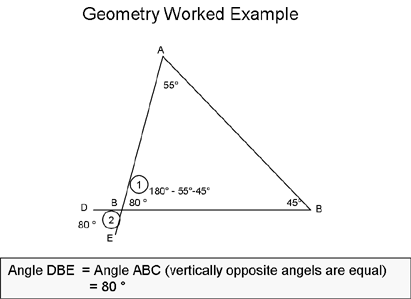
Worked-example effect
Encyclopedia
The worked-example effect is a learning effect predicted by cognitive load theory
(Sweller, 1988). According to Sweller: "The worked example effect is the best known and most widely studied of the cognitive load effects"(Sweller, 2006, p. 165).
Perhaps you have seen worked examples in textbooks. Worked examples like that above are commonly found in mathematics or geometry textbooks, but they are also used in other fields. Atkinson, Derry, Renkl, & Wortham (2000) reported worked examples had been developed for music, chess, athletics, and computer programming.
perspective (Sweller & Cooper, 1985; Cooper & Sweller, 1987; Sweller, 1988).
While studying problem-solving tactics, Sweller and Cooper used worked examples as a substitute for conventional problem-solving for those learning algebra. They found learners that studied worked examples, performed significantly better than learners who actively solved problems (Sweller & Cooper, 1985; Cooper & Sweller, 1987). Sweller and Cooper (1985) had developed worked examples as a means of limiting problem solving search.
Not all worked examples are print-based as those in the Tarmizi and Sweller study. Lewis (2005) for instance, proposed animated demonstrations are a form of worked example. Animated demonstrations are useful because this multimedia presentation combines the worked example, and modality effects within a single instructional strategy.
(Kalyuga, Ayres, Chandler, & Sweller, 2003). It is suggested that worked examples be faded over time to be replaced with problems for practice (Renkl, Atkinson & Maier, 2000). Thus it is important to consider the learner as well as the media while developing worked examples, else learners may not perform as expected.
Cognitive load
The term cognitive load is used in cognitive psychology to illustrate the load related to the executive control of working memory . Theories contend that during complex learning activities the amount of information and interactions that must be processed simultaneously can either under-load, or...
(Sweller, 1988). According to Sweller: "The worked example effect is the best known and most widely studied of the cognitive load effects"(Sweller, 2006, p. 165).
What is a worked example?
"A worked example is a step-by-step demonstration of how to perform a task or how to solve a problem" (Clark, Nguyen, Sweller, 2006, p. 190). Studying worked examples is an effective instructional strategy to teach complex problem-solving skills (van Merriënboer, 1997). This is because example-based instruction provides expert mental models, to explain the steps of a solution for novices.
Perhaps you have seen worked examples in textbooks. Worked examples like that above are commonly found in mathematics or geometry textbooks, but they are also used in other fields. Atkinson, Derry, Renkl, & Wortham (2000) reported worked examples had been developed for music, chess, athletics, and computer programming.
Evidence for the worked-example effect
Sweller and Cooper were not the first to use this form of instruction, but certainly they were the first to describe it from a cognitive loadCognitive load
The term cognitive load is used in cognitive psychology to illustrate the load related to the executive control of working memory . Theories contend that during complex learning activities the amount of information and interactions that must be processed simultaneously can either under-load, or...
perspective (Sweller & Cooper, 1985; Cooper & Sweller, 1987; Sweller, 1988).
While studying problem-solving tactics, Sweller and Cooper used worked examples as a substitute for conventional problem-solving for those learning algebra. They found learners that studied worked examples, performed significantly better than learners who actively solved problems (Sweller & Cooper, 1985; Cooper & Sweller, 1987). Sweller and Cooper (1985) had developed worked examples as a means of limiting problem solving search.
Developing effective worked examples
Ward and Sweller (1990) suggested that under some conditions "worked examples are no more effective, and possibly less effective, than solving problems" (p. 1). Thus it is important that worked examples be structured effectively, so that extraneous cognitive load does not impact learners. Chandler and Sweller (1992) suggested an important way to structure worked examples. They found that the integration of text and diagrams (within worked examples) reduces extraneous cognitive load. They referred to this single modality, attention learning effect as the split-attention effect (Chandler and Sweller, 1992). Tabbers, Martens, & Van Merriënboer (2000) proposed one may prevent split-attention by presenting text as audio.Not all worked examples are print-based as those in the Tarmizi and Sweller study. Lewis (2005) for instance, proposed animated demonstrations are a form of worked example. Animated demonstrations are useful because this multimedia presentation combines the worked example, and modality effects within a single instructional strategy.
For Which Learners?
As it turns out, worked examples are not appropriate for all learners. Learners with prior knowledge of the subject find this form of instruction redundant, and may suffer the consequences of this redundancy. This has been described as the expertise reversal effectExpertise reversal effect
The expertise reversal effect is related to cognitive load theories of learning. It states that guidance provided to experts can hinder their ability to learn: "learners would have to relate and reconcile the related components of available long-term memory base and externally provided guidance...
(Kalyuga, Ayres, Chandler, & Sweller, 2003). It is suggested that worked examples be faded over time to be replaced with problems for practice (Renkl, Atkinson & Maier, 2000). Thus it is important to consider the learner as well as the media while developing worked examples, else learners may not perform as expected.
See also
- Cognitive loadCognitive loadThe term cognitive load is used in cognitive psychology to illustrate the load related to the executive control of working memory . Theories contend that during complex learning activities the amount of information and interactions that must be processed simultaneously can either under-load, or...
- Example ChoiceExample ChoiceExample choice is a teaching method that has been developed and explored at the University of Bergen. The main objective is to make mathematics and science teaching more interesting and relevant to the daily life of students...
- Multimedia learningMultimedia learningMultimedia learning is the common name used to describe the cognitive theory of multimedia learning This theory encompasses several principles of learning with multimedia.-The Modality principle:...
- Split attention effectSplit attention effectThe split-attention effect is a learning effect inherent within some poorly designed instructional materials. It is apparent when the same modality is used for various types of information within the same display...
- Procedural memoryProcedural memoryProcedural memory is memory for how to do things. Procedural memory guides the processes we perform and most frequently resides below the level of conscious awareness. When needed, procedural memories are automatically retrieved and utilized for the execution of the integrated procedures involved...

